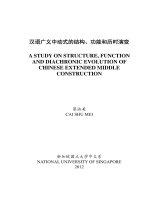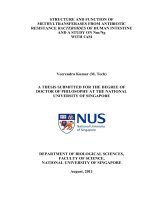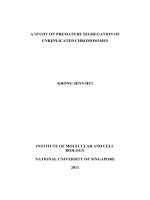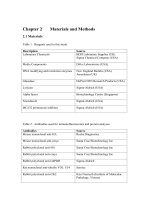A study on junk food consumption behaviour among college student
Bạn đang xem bản rút gọn của tài liệu. Xem và tải ngay bản đầy đủ của tài liệu tại đây (716.1 KB, 20 trang )
A Study on Junk Food Consumption Behaviour among College Students
By
Prof. A. H. Sequeira
NITK, Surathkal
A. Sowmya*
Beryl Thomas*
Chahat Mahajan*
Chandra Kumar*
* MBA Students, NITK, Surathkal
ABSTRACT
The study of junk food consumption behaviour among college students is aimed to
have an in depth analysis of food consumption trends and attitudes among college students.
The research takes up an exploratory approach and used primary data from sample survey
conducted on a quota sample to arrive to conclusions. The factors to be investigated in the
study were identified from secondary literature. Survey was conducted among a sample of
students through a documented self-administered questionnaire. Chi-square and Z-test were
carried out to analyse the survey data. The findings of the research lead to the conclusions
that the tendency of replacing regular meals with junk food was more with female students.
Further , Post Graduate students were more concerned about the health impacts of junk food
compared to Under Graduate students.
The research also indicates that factors like
accessibility, taste, price and ambience are having an influence in driving people towards
food outlets and these factors vary with gender and level of education.
Electronic copy
copy available
available at:
Electronic
at: /> />
INTRODUCTION
Junk Food is defined by Centre for Science and Environment as ―any food, which is
low in essential nutrients and high in everything else—in particular calories and sodium. Junk
foods contain little or no proteins, vitamins or minerals but are rich in salt, sugar, fats and are
high in energy (calories)‖. So the common perception about junk food and its consumption is
negative, since it happens to be a misfit in any good diet plan due to lack of nutritional value
and high calorie content.. But over the years, several studies have observed that the
consumers are opting for junk food in several instances. It has also been proven as a
profitable business sector to invest. The need for this study is this scenario, to find reasons for
people opting to pay and consume junk food and to know how much is their consumption
rates and awareness levels on what they are consuming. Past studies done world over have
suggested many reasons for this trend and through our study we try to see about the same in a
different context.
The younger generation is seen to be the most attracted to junk foods and this also has
been observed by several studies in the past. This study is made on the same category of
individuals. The population for the study restricts itself to the under and post graduate student
population of RIT to understand about the practices and perceptions of the younger
generation, aged around 17-25. The relevance of choosing RIT is that it is institute of
National repute in India. Further, students from all parts of the country are represented,
making it a population of individuals from diverse cultural, geographical and financial
backgrounds from across the country. This heterogeneity in population might provide results
that could be relevant for common trends in India. Most of the population being resident
students, and hence their practices and choices are assumed to be more independent. The
reasons for their choices of food habits can be a good indicator of the food habits of college
students in the country.
Objectives
The research project envisaged the following research questions and objectives listed
in Table 1.1.
i|Page
Electronic copy
copy available
available at:
Electronic
at: /> />
Table 1.1: Research Questions and Research Objectives
Research Questions
Research Objectives
1) How far junk foods are influencing the
regular food habits of students?
1) To understand the influence of the of
junk foods into the regular food
habits of students.
2) What is the attraction towards the taste
of junk foods among students?
2) To study influence of taste and
flavour of junk foods on students.
3) What is the influence of brand value
and attractiveness of fast food outlets
on the consumption among students?
3) To access the influence of brand
value
and
attractiveness
on
consumption of junk food
4) What is the accessibility to junk food
consumption?
4) To study the impact of accessibility
and secondary services of junk food
outlets on consumption behaviour
5) How do secondary factors like
ambience and service pattern at fast
food joints influence the behaviour?
5) To explore the awareness level
among students regarding the impact
of junk foods on health
6) What is the level of awareness among
students regarding the impact of junk
foods on health?
Hypotheses
Based on literature and experience, the following null and alternative hypotheses were
framed for the study.
H01: There is no difference of gender in the tendency of replacing regular meals with
junk food
HA1: There is difference of gender in the tendency of replacing regular meals with
junk food
H02: Concern about health has no difference between UG and PG students
HA2: Concern about health has difference between UG and PG students
H03: There no is significant relationship between factors affecting choice of junk food
and gender of the student
HA3: There is significant relationship between factors affecting choice of junk food
and gender of the student
ii | P a g e
Electronic copy available at: />
H04: There is no significant relationship between factors affecting choice of junk food
and education level of the student
HA4: There is significant relationship between factors affecting choice of junk food
and education level of the student
REVIEW OF RELATED LITERATURE
Several studies have taken place in vivid contexts related to junk food perceptions and its
reasons.
According to Mark K. Jekanowski (2001) the demand for fast food depends heavily on
the ease of consumer access to the product. The fast food industry has continually found ways
to make its product more accessible, and this effort continues today with retail outlets
appearing in such varied locations as office buildings, department stores and airports. Much
of the growth in consumption is due to increasingly supply of convenience.
A study by Firdause Abdullah (2011) explains that various dimension such as price
reasonableness, special pricing offers in menu packages, discounts, special prices for regular
customers, promotional pricing on new menu items and inclusion of local delicacies
influence the customer preference in food service industry. This study also reveals that brand
names, spacious seating arrangements, adequate parking space, wide variety of menu items
and attractiveness interior design have great influence in attracting customers.
According to Oyedunni S. Arulegun and Modupe (2011) despite there was a high level of
awareness and knowledge of the constituents of the fast food and its risk for developing Non
Communicable Diseases in future , respondents still engage in the consumption of this
category of foods.
A study conducted by Vinay Gopal J and his colleagues (2012) explains the role of
television advertisements in attracting the college students to junk foods. Majority of the
sample studied had admitted of getting addicted to junk foods. The study suggests a defiant
need for the young generation to understand that there are various chemical additives added
to the junk foods and about the negligible nutrient levels in junk foods, for cultivating an
effective, safe and healthy balanced diet.
A report given by Naheed Vaida (2013) says that consumption of fast food was high
during pre-lunch periods. The flavour/taste attracts the maximum percent of respondents
iii | P a g e
Electronic copy available at: />
while going for fast food. Most of the respondents prefer branded fast food items and are
willing to spend daily Rs.20-50 or more on buying fast food. Majority of respondents agreed
over the statement that eating of fast food is the way of showing that the respondents belong
to a higher society. He also said that majority of the respondents agreed that consumption of
fast food is more among girls than boys and agreed to the fact that urbanization has a greater
influence on changing food habits of students.
A study by Anita Goyal (2007) explains that young Indian consumer have the greatest
value for taste and quality followed by ambience and hygiene.
A study by Ya- li Huang (1994) explains that the students skipped breakfast (22%), lunch
(8%), and dinner (5%); 80 percent of the students snacked at least once a day. No significant
differences found in frequency of meals skipped and snacks consumed between male and
female.
A study by Sahasporn Paeratakul (2003) explains that fast-food use may decline at the
highest levels of education. In this study, people with 4 or more years of college education
reported lower fast-food consumption compared with those with high school or some college
education.
Summary of related literature is given in Table 2.1
Table 2.1: Summary of related literature
Author
Ya- li Huang
Year
1994
Findings
No significant difference between male and female in meals
skipped and snacks consumed
Mark K. Jekanowski
2001
Demand for fast food depends on ease of consumer access
Sahasporn Paeratakul
2003
Fast food use declines among students at highest level of
education
Anita Goyal
2007
Youngsters in India give most importance to taste and
quality, followed by ambience and hygiene
Firdause Abdullah
2011
Influence of price discounts, brand names, infrastructure
facilities on attracting customers to outlets
iv | P a g e
Electronic copy available at: />
Oyedunni S. Arulegun
and Modupe
2011
Consumption of fast food continues despite the awareness of
constituents and risks for developing diseases
Vinay Gopal J.
2012
Role of advertisements in attracting college students, need
of younger generation to cultivate balanced diet
Naheed Vaida
2013
Attraction towards taste, preference towards branded food
items to show that they belong to a higher class in society
Through the study of literature survey different variables were identified that were found to
be affecting demand and consumption of junk foods (dependent variable). The variables in
consideration for the study are listed in Table 2.2
Table 2.2: Independent and Dependent Variables identified
Independent Variables
Accessibility
Pricing & Discounts
Ambience
Amenities
Variety in Menu offerings
Taste
Quality
Brand Reputation
Service
Advertising
Hygiene
Gender
Level of Education
Dependent Variables
Consumption Behaviour of Junk Food
This research was mainly intended to study the effect of these independent variables
in detail and also to identify any other variables that tend to affect the consumption behaviour
of junk food among students of RIT.
METHODOLOGY
The study of junk food consumption among RIT students adopted an exploratory
study. It involved identifying the trends and behaviours of RIT students with regard to junk
food consumption. The effect various factors on junk food consumption behaviour were
identified as independent variables from the study of related literature.
v|Page
Electronic copy available at: />
Inductive and deductive reasoning were employed in the study. Survey data
comprised of primary data from subjects. A combination of quantitative and qualitative
strategy was used to capture the data. Hypotheses were tested by statistical data analysis (χ2
testing and z-test).
Tool
Survey method was used to conduct the study on a sample of the population using a
structured self-administered questionnaire (Appendix I)
Sampling
Quota sampling technique was used for the population of size 4800. The population
comprised of about 75 percent male and 25 percent female students; about 72 percent of
undergraduate students and 28 percent of postgraduate students. The same ratio of these
categorizations was maintained to select the sample. Within the quota, convenience sampling
was used. Sample size was calculated as 355 with 95 percent confidence. The procedure of
calculation of sample is provided in Appendix II. The categorical distribution of the sample
based on quota sampling employed has been shown in Table 3.1.
Table 3.1: Categorical distribution of sample chosen
Category
UG students
PG students
Total
Male
191
75
266
Female
64
25
89
Total
255
100
355
RESULTS AND DISCUSSION
Considering the trend of replacing regular meals with junk food, nearly 75-80
percent of the students responded as they would do it at times (often, occasionally and
rarely), while only less than 5 percent were always opting for junk food. Rest of the
population never followed such a habit. The percentage trend, shown separately for
undergraduate and postgraduate students is shown in Figure 4.1. It was also observed that the
trend was almost similar between undergraduate and postgraduate students.
vi | P a g e
Electronic copy available at: />
40
35
30
25
UG
20
PG
15
10
5
0
always
often
occassionaly
rarely
never
Figure 4.1: Percentage of UG/PG Students who opt junk foods instead of regular meals
Source: Survey Data
In an analysis of the same trend between male and female students, the tendency has
been observed to have a relationship, thereby rejecting the Null Hypothesis H01. Here a
significantly higher percentage of female students were observed to consume junk food meal
often. The analysis of observations is given in Table 4.1.
Null Hypothesis H01=There is no difference of gender in the tendency of replacing regular
meals with junk food
Alternate Hypothesis HA1= There is difference of gender is the tendency of replacing regular
meals with junk food
Table 4.1: Students on whether they replace regular meals with junk food
Gender\Response
Always
Often
Occasionally
Rarely
Never
Total
Male
10
27
102
79
48
266
Female
1
29
27
19
13
89
Total
11
56
129
98
61
355
Source: Survey Data
Note 1: χ 2 = 26.092
Note 2: d.f = 4; α = 0.05 => Critical Value = 9.49
vii | P a g e
Electronic copy available at: />
HA1 accepted. There is difference of gender is the tendency of replacing regular meals with
junk food. The observation is graphically represented as shown in Figure 4.2
45
40
35
30
25
male
20
female
15
10
5
0
always
often
occassionaly
rarely
never
Figure 4.2: Percentage of M/F Students who opt for junk foods instead of regular meals
Source: Survey Data
In an analysis of the factors that are influencing the food habits of students, it was
observed that availability and time constraint make people opt their existing food habits. This
was observed to be similar for male and female students. For more than 40 percent of the
respondents, availability was the driving factor while over 20 percent were driven by time
constraints and schedules that gave them fewer choices.
The factors influencing food habits and corresponding percentage of students who
were influenced by each of the factors are shown in Figure 4.2
viii | P a g e
Electronic copy available at: />
45
40
35
30
25
MALE
20
FEMALE
15
10
5
0
availibilty
time constraint
peer pressure
price factor
others
Figure 4.3: Percentage of students vs Factors affecting their food habits
Source: Survey Data
In an analysis of the level of concern of students about the health impacts of junk
foods, nearly 60 percent responded that they are ―somewhat concerned‖ about it. While 20
percent were highly concerned, the rest were not much concerned on this aspect. Both
genders responded in a similar way in this aspect. A graphical representation of this data is
shown in Figure 4.3
70
60
50
40
MALE
30
FEMALE
20
10
0
very much concerned somewhat concerned don't worry about it
don't care
Figure 4.4: Percentage of M/F Students vs. Level of concern on health impacts of junk
food
Source: Survey Data
ix | P a g e
Electronic copy available at: />
When the same response set is analysed after classifying respondents on the basis of
whether he/she is an undergraduate or postgraduate student, it was found that a larger
percentage of postgraduate students are having high level of concern compared to
undergraduate students. This relationship means the second null hypothesis of the project can
be rejected. The observed data is available in Table 4.2 along with corresponding statistical
testing shown below.
Null Hypothesis H02= Concern about health has no difference between UG and PG students
Alternate Hypothesis HA2= Concern about health has is different between UG and PG
students
Table 4.2: Responses from sample regarding concern about health
Degree\Response
Very Much
Somewhat
Don't Worry
Don't care
Total
UG
42
155
42
16
255
PG
36
45
11
8
100
Total
78
200
53
24
355
Source: Survey Data
Note 1: χ 2 = 17.40161
Note 2: d.f = 3; α = 0.05 => Critical Value = 7.82
HA2 accepted. Concern about health has is different between UG and PG students.
The graphical representation of the observation is shown in Figure 4.5 and this clearly
indicates the difference in percentage of respondents in the first two options. This indicates
that the postgraduate students have an overall increased concern over health impact of junk
food consumption.
x|Page
Electronic copy available at: />
70
60
50
40
UG
30
PG
20
10
0
very much concerned
somewhat concerned
don't worry about it
don't care
Figure 4.5: Percentage of UG/PG Students vs. Level of concern on health impacts of
junk food
Source: Survey Data
The survey had asked its respondents about how they would on a scale of 1 to 5 give
their rating of importance while choosing a place to eat outside. They were asked to rate on
13 factors, the factors were statistically tested for relationships with regard to gender and
level of education. The observations and testing of third and fourth null hypotheses are given
along with Tables 4.3 to 4.8.
Table 4.3: Rating for factors of preference: Male students
Rating →
variables↓
Quality
Hygiene
Brand Reputation
Taste
Ambience
Service
Add On Facilities
Variety In Menu
Discount Scheme
Nutritional
Values
Accessibility
Hours
of
operation
Price
Source: Survey Data
1
2
3
4
5
10
9
49
7
21
16
120
37
31
20
44
20
90
22
66
54
120
30
110
76
66
141
315
54
342
273
114
204
159
138
376
256
180
220
208
344
104
368
112
392
590
680
110
875
230
230
110
270
495
320
Total no.
of
students
266
266
266
266
266
266
266
266
266
266
15
32
56
64
111
213
432
228
390
370
266
266
12
26
87
288
700
266
xi | P a g e
Electronic copy available at: />
Table 4.4: Rating for factors of preference: Female students
Rating →
variables↓
1
2
3
4
5
Quality
9
Hygiene
9
Brand
10
Reputation
Taste
3
Ambience
4
Service
8
Add On facilities
27
Variety In Menu
4
Discount scheme
4
Nutritional
5
values
Accessibility
9
Hours
of
11
operation
Price
9
Source: Survey Data
6
14
32
15
39
66
144
92
108
180
185
70
Total no.
of
students
89
89
89
12
20
22
40
20
36
16
54
99
57
51
72
78
63
80
112
156
52
132
100
136
210
70
60
60
90
80
105
89
89
89
89
89
89
89
20
38
48
96
160
60
70
60
89
89
14
66
84
150
89
Null hypothesis: H03= There no is significant relationship between factors affecting choice of
junk food and gender of the student.
Alternative hypothesis: HA3=There is significant relationship between factors affecting
choice of junk food and gender of the student.
Table 4.5: Z-test Analysis Values for Gender relationship
variables
Quality
Hygiene
Brand Reputation
Taste
Ambience
Service
Add On Facilities
Variety In Menu
Discount Scheme
Nutritional Values
Accessibility
Hours Of Operation
Price
z-test value
2603.90326
10544.84681
-21646.6867
8881.280302
-3947.53402
1007.779087
-20238.8334
-6275.7178
2965.062544
-3536.40456
14370.37029
23338.8127
20321.0415
xii | P a g e
Electronic copy available at: />
Significance level: α=0.05
Interpretation: Because the calculated Z for brand reputation, ambience, add on facilities,
variety in menu and nutritional value are less than the critical z = -1.645 (and in the rejection
region),and also the z-value of other factors i.e. quality, hygiene, taste, service, discount
scheme, accessibility ,hours of operation and price are more than z= 1.645 (again in rejection
region) reject null hypothesis H0 at the 0.05 significance level that there are significant
relationship between factors affecting choice of junk food and gender of the student.
Table 4.6: Rating for factors of preference: PG students
Rating →
variables↓
Quality
Hygiene
Brand Reputation
Taste
Ambience
Service
Add on Facilities
Variety In Menu
Discount Scheme
Nutritional Values
Accessibility
Hours of operation
Price
Source: Survey Data
1
2
3
4
5
6
8
10
5
15
8
28
15
10
4
6
19
5
22
8
30
10
36
34
66
28
58
20
26
30
18
12
24
102
66
42
60
51
78
57
60
39
105
51
164
32
104
44
140
148
64
120
72
200
192
72
104
190
360
75
285
90
90
30
75
120
80
100
65
215
Total no.
of
students
100
100
100
100
100
100
100
100
100
100
100
100
100
Table 4.7: Rating for factors of preference: UG students
Rating →
variables↓
1
Quality
Hygiene
Brand Reputation
Taste
Ambience
Service
Add on Facilities
Variety In Menu
Discount Scheme
Nutritional
Values
Accessibility
Hours of
Operation
Price
2
3
4
5
13
10
49
5
10
16
119
26
25
21
28
26
92
24
50
42
94
22
88
72
69
156
279
42
399
270
114
198
180
141
356
316
184
256
180
352
92
380
140
328
580
505
105
800
210
200
140
285
455
345
Total no.
of
students
255
255
255
255
255
255
255
255
255
255
18
24
50
72
120
204
400
216
360
365
255
255
16
22
102
268
635
255
xiii | P a g e
Electronic copy available at: />
Source: Survey Data
Null hypothesis: H04= There is no significant relationship between factors affecting choice of
junk food and education level of the student.
Alternative hypothesis: HA4= There are significant relationship between factors affecting
choice of junk food and level of education of the student.
Table 4.8: Z-test Values for level of education
Variables
Quality
Hygiene
Brand Reputation
Taste
Ambience
Service
Add On Facilities
Variety In Menu
Discount Scheme
Nutritional Values
Accessibility
Hours of Operation
Price
z-test value
-34430.0929
-12971.1547
-39775.7617
-30109.2736
-69386.1207
-59188.982
-43676.4659
-85131.0442
-81088.4703
-41995.1724
-48185.7569
-97806.6767
-34847.3968
Significance level: α=0.05
Interpretation: Because the calculated Z for quality, hygiene, brand reputation, ambience,
add on facilities, variety in menu, nutritional value, taste, service, discount scheme,
accessibility, hours of operation and price, are less than the critical z = -1.645 (and in the
rejection region) reject null hypothesis H0 at the 0.05 significance level that there are no
significant relationship between factors affecting choice of junk food and level of education
of the student.
Limitations:
This exploratory study has some limitations even though the actual purpose of the study is
not affected by them. One factor is that the scope of the study is limited to college students,
ignoring the rest of the people of lower and higher age group. Also the study being carried
out in an Indian context may not hold true universally.
CONCLUSION
The main findings from the research confirms to the findings from literature . The
independent variables that influence the consumption behaviour were also found to vary with
certain aspects of gender and level of education.
xiv | P a g e
Electronic copy available at: />
It was observed that students tend to replace regular meals with junk food
occasionally, and in this aspect the female students were showing a greater tendency
compared to male students.
Both the gender and level of education were observed to have an impact on the
various factors that they consider while choosing a place to eat out.
Male students are found to be more concerned about the quality and hygiene of the eat
out places than female. Female students have more compulsions and loyalties with regard to
brands than males.
Both male and female students consider taste as an important factor while eating out
place. Ambience and secondary factors were rated low by both genders.
Variety of menu, nutritional value and accessibility has impact on both male and
female students. About discount schemes and hours of operation of junk food outlets, male
students are giving more importance.
It was also observed that the post graduate students had a greater concern about health
impacts of junk foods compared to undergraduates.
BIBLIOGRAPHY
Anita Goyal, N.P. Singh. (2007). Consumer perception about fast food in India: an
exploratory study. British Food Journal, 109, 182 – 195.
Firdaus Abdullah, Abg Zainoren, Abg Abdurehman, Jamil Hamel. (2011). Identifying
the dimension of customer preference in food service industry. International
Conference on Innovation, Management and Service, 14
Mark D. Jekanowski, James K. Biknkley, and James Eales. (2011).Convenience,
accessibility and demand for fast food. Journal of Agricultural and Resourse
Economics Association, 26, 58-74.
Naheed Vaida. (2013). Prevalence of Fast Food intake among Urban Adolescent
students. The international Journal of Engineering and Science (IJES), 2, 2319-1805.
Oyedunni S. Arulogan, Modupe O. Owalabi. (2011). Fast food consumption pattern
among under graduate of the university of Ibadan, Nigeria: Implication for nutrition
education. Journal of Agricultural and Food Technology, 1, 89-93.
Sahasporn Paeratakul, Daphne P. Ferdinand, Catherine M. Champagne, Donna H.
Ryan, George A. Bray.(2003).Fast-food consumption among US adults and children:
xv | P a g e
Electronic copy available at: />
Dietary and nutrient intake profile. Journal of The American Dietetic Association,
103, 1332-1338.
Vinay Gopal J., Sriram S., Kannabiran K. and Seenivasan R. (2012).Student’s
perspective on junk foods: Survey.Sudanes journal of public health, 2, 21-25.
Ya-Li Huang, Won O.Song, Rachel A. Schemmel, and Sharon M. Hoerr. (1994).
What do college students eat? Food selection and meal pattern. Nutritional research,
14, 1143–1153.
APPENDIX I
Survey Questionnaire
Age:
Gender: Male/Female
Year of Admission:
Programme: B.Tech/ M.Tech/ M.Sc/MCA/MBA
Department:
1. Where do you prefer dining while having food from outside?
Fine Dine Restaurants
Mid-range restaurants
Casual Dine Restaurants
(Fast food franchisee outlets etc)
Street Shops
2. What is your personal opinion about junk foods?
I love it
I like it
I don’t like it
I hate it
I’m okay with it
3. As a child how often were you having junk foods?
Never
< 3 times a week
5-7 times a week
More than 7 times
3-5 times a week
4. How often do you eat junk foods now?
Never
< 3 times a week
5-7 times a week
More than 7 times
3-5 times a week
xvi | P a g e
Electronic copy available at: />
5. Do you ever replace a regular meal (breakfast/lunch/dinner) with a packet/plate
of junk food?
Always
Often
Rarely
Never
Occasionally
6. How does being in RIT affect your food choices compared to being at home?
Greatly affected
Sometimes
Rarely
Not at all affected
7. What all reasons do you feel; affect your eating choices at RIT?
Availability/Access
Time constraints
Price factors
Others
Peer pressure
8. Do you have any brand specifications or loyalties with regard to food items and
outlets?
Yes I always have only my favourite
brand’s food items
I like some brands and outlets
I have no such compulsions
I don’t buy branded food
9. *Does the taste of junk food items draw you towards consuming them?
Yes only for taste
Taste is also good
Taste is not the key factor
I have other reasons
10. *Do you choose junk food items since they are readily available to you?
Yes
It is also a reason
Not a key reason
I have other reasons
xvii | P a g e
Electronic copy available at: />
11. *Will you buy/consume more of junk food items when they are offered with
attractive discount prices (like Buy one Get one, Unlimited meals etc)
Yes for sure
I may utilize it
May not be
Never
Depends on the day
12. Which of the factors do you consider most while choosing an eat-out place? Rate
each option with a number rating from 1 (for least considered) to 5 (for most
considered)
Quality
Hygiene
Brand Reputation (feeling and pride of eating at XYZ Restaurant)
Taste
Ambience
Service (speed In addressing order, attitude etc)
Add on facilities (like TV/ Wi-Fi)
Variety in Menu Offerings
Discount Schemes
Nutritional Value
Accessibility (Nearness/Vehicular access/Parking etc)
Hours of operation
13. Do you use door delivery service provided by fast food outlets? (Including RIT
Night Canteen)
Very often
Often
Rarely
Not at all
14. *How concerned are you regarding the effects that junk food can have on your
health?
Very much concerned
Somewhat concerned
Don’t worry about it
Don’t care
xviii | P a g e
Electronic copy available at: />
15. *If you are offered a readily available, good quality, easily accessible and healthy
alternative for your usual junk meals, would you compromise upon the taste and
price aspects?
No way
I may try
I will try
For sure
*optional if you don’t have a habit of eating junk foods
APPENDIX II
Sample Size Calculation
Cross sectional research design was adopted for the study .Data was collected regarding total
number of students at RIT which is approximately 4800. Sample size was calculated using
following formula:
Sample size (SS) = Z2*p*(1-p)/e2
………. (1)
Where, Z= standard error (1.96 for 95% confidence level)
p= worst case proportion (0.5)
e= confidence interval taken in decimal
Sample Size for Finite Population (where the population is less than 50,000)
= SS/{ 1+ (SS-1)/P}
………(2)
Where P = population
Assumed the following,
Confidence level= 95%
Significance level= 5%
Confidence interval= 0.05
Using both formula sample sizes was arrived as 355.
xix | P a g e
Electronic copy available at: />









